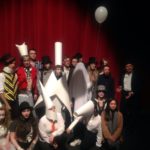
PhD student in History of Art Erica O’Neill tells us about her involvement with the Take Me Somewhere festival.
On Saturday 25th February, Andy Arnold and his troupe at the Tron Theatre, Glasgow invited audiences to explore parts of the Tron (and parts of themselves) they may never have seen before. They were taken on a strange journey, by even stranger characters on a promenade performance to the dark recesses of the backstage domain of the Tron. Nowhere, part of TAKE ME SOMEWHERE, (a new citywide festival of contemporary performance that builds on the legacy of The Arches arts programme) included performances inspired by Samuel Beckett’s Absurdism, existentialism, surrealism, and –on my suggestion and under my direction – Dada. There were six performance stations, to which the audience were led by a group of Royal Conservatoire of Scotland, Contemporary Performance Practice students, styled by me (fabricated by Alisa Kalyanova and Vicky Brown), in restrictive cardboard tubes and incongruous clothing apparatus. A nod to Hugo Ball’s Magical Bishop, and Tristan Tzara’s Dada theatre, the effect was an unholy array of strange characters resembling creatures from Hieronymus Bosch’s Garden of Earthly Delights.
When arriving at the theatre foyer, a master of ceremonies, played by Arnold himself,
directed the audience into six groups. Couples and friends arriving together were separated and commanded to await further instruction. Nowhere in Nowhere would theatre goers find a comfortable familiarity within which to retreat.
As assistant to director Arnold, I was responsible for directing the students in moments of Dada inspired performance: the public were treated to a wholly immersive theatrical experience as they travelled from station to station led by their Dada guides. The students’ striking physicality varied dependent on their costume appendages. Moving in unusual ways at an unnatural speed, spouting words of incoherent babble, the student chorus were directed to find inspiration in Tzara’s command, that “thought is made in the mouth.”

Never for a moment in Nowhere, did the atmosphere retreat from the bizarre. Guests incapable of escaping their theatrical contract dully followed as they were led into: complete darkness for an aural performance; an enclosed stationary elevator within which a man in pyjamas recounted a disturbing tale of a giant snake and infanticide; a corridor where a blindfolded man described sounds he listened to through earphones which the audience could not hear; and a backstage passage where a magician, trapped in a seemingly existential crisis, attempted to write a memoir while his pencil continued to escape his hand.
Other performances included an absent/present ghost, who exited on arrival of the audience, only to return for the completion of the performance. Guests may have realised that they had already witnessed this performance, as the ghost could be seen spectrally travelling around the theatre, passing by other groups and performers, before returning to her space. The absent presence of the performer was expertly examined in this piece, as audience members awkwardly waited for something to happen, and nothing did. This was the overall sentiment of Nowhere, and for the finale, guests were ushered into the main auditorium for Becket’s Breath (a half-minute performance consisting of stage curtains opening onto an empty stage littered with detritus, and then closing again after the sound of an inhaling then exhaling breath, bracketed by a baby’s cry). Before the curtains opened for Breath, the master of ceremonies encouraged the audience to resist looking for meaning in Nowhere. Explaining that perhaps only critics, who’s task it is to look for meaning in theatre, “might search in their pockets to find a spare meaning, which they will attach with wire and string to the play.”
Nowhere was a visceral personal experience, for me as assistant director (made possible after my AHRC Student Development Funded Dada workshops) but crucially for the audience. One guest confided in me that she was so fully immersed in the atmosphere, that she became convinced that fellow guests in her designated group might also have been part of the show; that they might have broken into performance at any moment. That, I believe, is to say that the atmosphere created at Nowhere was truly successful: that in the realm of one of Dada’s greatest ambitions, art indeed infiltrated life.

